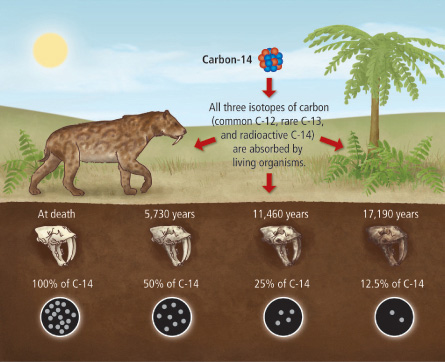Live Classes

In the Gyanvapi case, the petitioners want to establish that the ‘Shivling’ existed in its place much before the mosque came into being through carbon dating.
A district court in Varanasi on Thursday (September 22) allowed a petition seeking carbon dating of the structure inside the Gyanvapi mosque that the Hindu side has claimed is a ‘Shivling’. The court has issued notices to other parties wanting to know whether they have any objection to carbon dating.
What is carbon dating?
Carbon dating is a widely-used method applied to establish the age of organic material, things that were once living. Living things have carbon in them in various forms. The dating method makes use of the fact that a particular isotope of carbon called C-14, with an atomic mass of 14, is radioactive, and decays at a rate that is well known.
The most abundant isotope of carbon in the atmosphere is carbon-12 or a carbon atom whose atomic mass is 12. A very small amount of carbon-14 is also present. The ratio of carbon-12 to carbon-14 in the atmosphere is almost static, and is known.
Plants get their carbon through the process of photosynthesis, while animals get it mainly through food. Because plants and animals get their carbon from the atmosphere, they too acquire carbon-12 and carbon-14 isotopes in roughly the same proportion as is available in the atmosphere.
But when they die, the interactions with the atmosphere stops. There is no further intake of carbon (and no outgo either, because metabolism stops). Now, carbon-12 is stable and does not decay, while carbon-14 is radioactive. Carbon-14 reduces to one-half of itself in about 5,730 years. This is what is known as its ‘half-life’.
So, after a plant or animal dies, the ratio of carbon-12 to carbon-14 in the body, or its remains, begins to change. This change can be measured and can be used to deduce the approximate time when the organism died.
What about non-living things?
Though extremely effective, carbon dating cannot be applied in all circumstances. Specifically, it cannot be used to determine the age of non-living things, like rocks, for example. Also, the age of things that are more than 40,000-50,000 years cannot be arrived at through carbon dating. This is because after eight to ten cycles of half-lives have been crossed, the amount of carbon-14 becomes almost negligible and undetectable.
There are other methods to calculate the age of inanimate things, but carbon dating can also be used in an indirect way in certain circumstances. For example, the age of the ice cores in glaciers and polar regions is determined using carbon dating by studying the carbon dioxide molecules trapped inside large ice sheets. The trapped molecules have no interaction with the outside atmosphere and are found in the same state as when they were trapped.
How long a rock has been at a particular place can also be determined using similar indirect methods. If there are organic materials, dead plants or insects trapped beneath the rock, they can give an indication of when that rock, or any other thing, had reached that place.
There are various other methods to date sedimentation around an object, for example, that are used depending on the specific situation. In the Gyanvapi case, the petitioners want to establish that the ‘Shivling’ existed in its place much before the mosque came into being. Ascertaining that is theoretically possible.
Is there anything that cannot be dated?
Though a variety of methods exist to know the age of a certain object, not everything can be dated. The accuracy of the different methods also varies.
Though the petitioners in the Gyanvapi case have asked for carbon dating, it is not clear as of now whether carbon dating can be applied in this case, or if some other methods would be suitable. Some methods, like looking for trapped organic material beneath it, might not be feasible for practical reasons because that would involve uprooting the structure or making some other disruptions that are not desirable. What can be done to date the structure can be finalized only after a detailed study.
Paper - 3 (Sci & Tech.)
Writer - Amitabh Sinha (Editor)
Download pdf to Read More